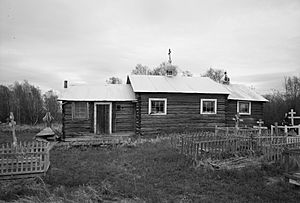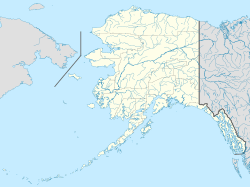Lower Kalskag, Alaska facts for kids
Quick facts for kids
Lower Kalskag, Alaska
Qalqaq
|
|
|---|---|

The historic St. Seraphim Chapel
|
|
| Country | United States |
| State | Alaska |
| Census Area | Bethel |
| Incorporated | 1969 |
| Area | |
| • Total | 1.75 sq mi (4.53 km2) |
| • Land | 1.24 sq mi (3.22 km2) |
| • Water | 0.51 sq mi (1.31 km2) |
| Elevation | 26 ft (8 m) |
| Population
(2020)
|
|
| • Total | 278 |
| • Density | 223.47/sq mi (86.27/km2) |
| Time zone | UTC-9 (Alaska (AKST)) |
| • Summer (DST) | UTC-8 (AKDT) |
| ZIP code |
99626
|
| Area code | 907 |
| FIPS code | 02-45460 |
| GNIS feature ID | 1405763 |
Lower Kalskag is a small city in Alaska, United States. Its name in the local Yup'ik language is Qalqaq. It is located in the Bethel Census Area. Lower Kalskag is about 26 miles west of another town called Aniak.
In 2010, about 282 people lived here. By 2020, the population was 278. The city was officially formed in 1969.
Contents
Where is Lower Kalskag?
Lower Kalskag is found at coordinates 61.513735 degrees North and -160.359050 degrees West. It covers a total area of about 1.7 square miles (4.5 square kilometers). Most of this area, about 1.3 square miles (3.2 square kilometers), is land. The rest, about 0.4 square miles (1.3 square kilometers), is water.
Locals often just call the city "Lower." It is connected to a nearby town, Upper Kalskag, by a two-mile long gravel road. People usually call Upper Kalskag "Upper."
How to Get to Lower Kalskag
Getting to Lower Kalskag can be an adventure!
- You can fly there on a small plane.
- Boats are another way to reach the city.
- In winter, when the river freezes, people can use vehicles on the "ice road."
Lower Kalskag's Population History
Lower Kalskag has been counted in the U.S. Census for many years.
| Historical population | |||
|---|---|---|---|
| Census | Pop. | %± | |
| 1940 | 76 | — | |
| 1950 | 88 | 15.8% | |
| 1960 | 122 | 38.6% | |
| 1970 | 183 | 50.0% | |
| 1980 | 246 | 34.4% | |
| 1990 | 291 | 18.3% | |
| 2000 | 267 | −8.2% | |
| 2010 | 282 | 5.6% | |
| 2020 | 278 | −1.4% | |
| U.S. Decennial Census | |||
The city first appeared on the census in 1940. Back then, it was mistakenly listed as just "Kalskag." In 1950, it was correctly called Lower Kalskag. The city officially became a city in 1969.
Who Lives in Lower Kalskag?
In 2000, there were 267 people living in Lower Kalskag. These people lived in 66 different homes. Most homes, about 62%, had children under 18 living there.
The population of Lower Kalskag is quite young.
- Almost half, about 45%, were under 18 years old.
- About 13.5% were between 18 and 24.
- About 22% were between 25 and 44.
- About 15% were between 45 and 64.
- Only about 4% were 65 years or older.
The average age in the city was 21 years old.
See also
 In Spanish: Lower Kalskag para niños
In Spanish: Lower Kalskag para niños


